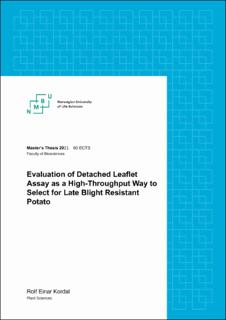| dc.contributor.advisor | Alsheikh, Muath | |
| dc.contributor.advisor | Brurberg, May Bente | |
| dc.contributor.author | Kordal, Rolf Einar | |
| dc.date.accessioned | 2022-11-04T12:56:02Z | |
| dc.date.available | 2022-11-04T12:56:02Z | |
| dc.date.issued | 2022 | |
| dc.identifier.uri | https://hdl.handle.net/11250/3030195 | |
| dc.description.abstract | The potato (Solanum tuberosum) is the world’s third most important food crop. It is grown all over the world. Late blight is an important disease in potato, caused by the pathogen Phytophthora infestans. The disease causes large crop losses and infects both the foliage and tubers, if not controlled by fungicide application. Developing new potato cultivars with improved resistance against late blight, is important in breeding programs, as these would allow less frequent spraying and a more sustainable potato production. Resistance against foliage late blight is usually evaluated in large scale field trials. Such trials are often expensive, difficult to manage and control. Alternative ways of assessing resistance that is cost-effective, high-throughput and precise are therefore of great interest.
The purpose of this thesis is to investigate whether a detached leaflet assay (DLA) can be used to detect resistance against foliage late blight in different potato genotypes. This was investigated through assessment of 255 cultivars and breeding material (genotypes) representing the Norwegian germplasm. One plant per genotype was grown in pots in a greenhouse. After 8 weeks, leaves were detached and 9 leaflets per genotype were placed in Petri dishes and inoculated with P. infestans. The infection was assessed visually and by image analysis 6 and 8 days after inoculation. The results were compared with historical field data, and a genome-wide association study was performed.
The results showed that the leaf test was able to distinguish potato genotypes based on their susceptibility to late blight. There was a low frequency of infection on the leaflets. A reason for this may be that the inoculum had reduced infectivity due to age. The correlation between the DLA and the historical field data was limited, but significant. The leaf test was able to identify the potato genotypes most susceptible to late blight. The association study found several significant markers. A marker found on chromosome 3, was located near a known QTL for late blight resistance.
It can be concluded that the DLA can be used to identify the genotypes that are most susceptible to foliage late blight before an eventual field trial. | en_US |
| dc.description.abstract | Potet (Solanum tuberosum) er verdens tredje viktigste matplante. Den dyrkes over hele verden. Tørråte er en viktig potetsykdom, og forårsakes av skadegjøreren Phytophthora infestans. Tørråte kan føre til store avlingstap og kan angripe både riset og knollene om det ikke sprøytes jevnlig. Utvikling av nye potetsorter med forbedret motstandsdyktighet mot tørråte er viktig i potetforedling, ettersom slike potetsorter kan føre til sjeldnere sprøytninger og en mer bærekraftig produksjon. Resistens mot tørråte på ris vurderes vanligvis i feltforsøk. Feltforsøkene er ofte kostbare, vanskelige å administrere og kontrollere. Alternative måter for å teste tørråteresistens som både er presise, tidseffektive og kostnadseffektive er derfor av stor interesse.
Hensikten med denne oppgaven er å undersøke om en bladtest kan benyttes til å avdekke resistens mot tørråte på ris blant potetgenotyper. Dette ble undersøkt ved hjelp av 255 ulike potetsorter og foredlingskloner (genotyper) som representerer arvemassen til norsk potet. En plante per genotype ble dyrket i potter i et drivhus. Etter 8 uker ble blader høstet inn og 9 småblad per genotype ble plassert i Petriskåler og inokulert med P. infestans. Infeksjonen ble vurdert visuelt og ved bildeanalyse 6 og 8 dager etter inokulasjon. Resultatene ble sammenlignet med historiske feltdata, og det ble utført en genomvid assosiasjonsstudie (GWAS).
Resultatene viste at bladtesten klarte å skille mellom potetgenotypene basert på deres mottakelighet for tørråte. Det var i utgangspunktet få blad som ble infisert. En årsak til dette kan ha vært at smitteløsningen var lite smittsom på grunn av alder. Korrelasjonen mellom bladtesten og de historiske feltdataene var begrenset, men signifikant. Bladtesten klarte å identifisere potetgenotypene som var mest mottakelige for tørråte. Assosiasjonsstudien fant flere signifikante markører. En markør funnet på kromosom 3, var lokalisert nær en tidligere omtalt kvantitative arveegenskap (QTL) for tørråteresistens.
Det kan konkluderes med at bladtester kan benyttes for å identifisere genotypene som er aller mest mottakelige for tørråte på ris før et eventuelt feltforsøk. | en_US |
| dc.language.iso | eng | en_US |
| dc.publisher | Norwegian University of Life Sciences, Ås | en_US |
| dc.rights | Attribution-NonCommercial-NoDerivatives 4.0 Internasjonal | * |
| dc.rights.uri | http://creativecommons.org/licenses/by-nc-nd/4.0/deed.no | * |
| dc.title | Evaluation of Detached Leaflet Assay as a High-Throughput Way to Select for Late Blight Resistant Potato | en_US |
| dc.type | Master thesis | en_US |
| dc.subject.nsi | VDP::Landbruks- og Fiskerifag: 900 | en_US |
| dc.description.localcode | M-PV | en_US |

